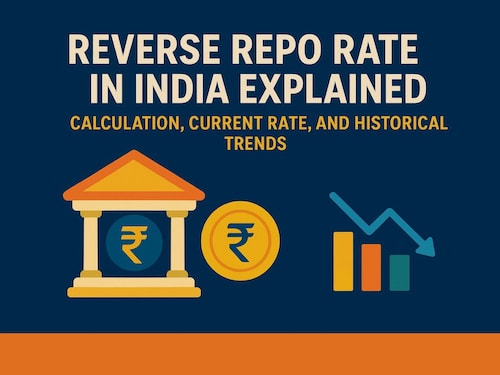Reverse repo rate in India explained: Calculation, current rate, and historical
Know about the reverse repo rate in India set by the RBI and how it impacts inflation, liquidity, interest rates, and the economy


Policy rates play a critical role in shaping the Indian economy. These rates can sound like economic jargon to most of us. Still, they are determined by the Reserve Bank of India (RBI) and directly influence lending, borrowing, and overall economic stability. Among these, the reverse repo rate is especially important in personal loans and helps the RBI manage liquidity and control inflation.
In this post, we’ll discuss what the reverse repo rate is, why it matters, and how it impacts the broader economy. This guide will give you clear insights, especially if you’re looking to apply for loans or understand them.
The reverse repo rate in India is the interest rate at which the RBI accepts deposits from commercial banks, usually for short durations. This is a crucial tool for managing liquidity in the financial system. It allows the RBI to absorb surplus cash from the market, helps keep inflation in check, and maintains economic stability.
When the RBI raises the reverse repo rate, it becomes more attractive for banks to deposit their excess funds with the central bank, as the return is higher. This reduces the amount of money available for lending in the broader economy, which can help cool down inflation. On the contrary, lowering this rate can push banks to lend more money and improve economic activity. It’s a flexible, powerful approach to steer the economy based on the evolving financial conditions.
As of May 2025, the RBI has maintained the reverse repo rate at 3.35 percent. This rate has remained unchanged since mid-2020, serving as a tool to manage liquidity in the market. By adjusting the reverse repo rate, the RBI influences the amount of funds banks are willing to lend versus hold, thereby impacting overall economic activity. The reverse repo rate is always set lower than the repo rate, which is currently set at 6 percent.
| Date | Reverse repo rate (in percent) |
| 2021 to present | 3.35 (unchanged) |
| Dec 04, 2020 | 3.35 |
| Oct 09, 2020 | 3.35 |
| Aug 06, 2020 | 3.35 |
| May 22, 2020 | 3.35 |
| Apr 17, 2020 | 3.75 |
| Mar 27, 2020 | 4.15 |
| Feb 06, 2020 | 4.90 |
| Dec 05, 2019 | 4.90 |
| Oct 04, 2019 | 4.90 |
| Aug 07, 2019 | 5.15 |
| Jun 06, 2019 | 5.50 |
| Apr 04, 2019 | 5.75 |
| Feb 07, 2019 | 6.00 |
| Jan 31, 2019 | 6.25 |
The reverse repo rate is finalised by the Reserve Bank of India (RBI) via the Monetary Policy Committee (MPC) based on economic indicators like inflation, liquidity levels, and overall market stability. Unlike the repo rate, it doesn't have a fixed formula. Instead, the MPC reviews market data, financial trends, and government fiscal policies before deciding on an appropriate rate.
The reverse repo rate influences several aspects of the Indian economy:
Now that we know what the reverse repo rate is, let’s compare it with the repo rate. The repo rate, short for ‘repurchasing agreement,’ is the interest rate at which the RBI lends funds to commercial banks against government securities.
| Specifics | Reverse repo rate | Repo rate |
| Lender and borrower | Commercial banks deposit money with the RBI | RBI lends money to the commercial banks |
| Objective | To help reduce the excess liquidity from the banks in the Indian economy | It provides short-term liquidity to the banks |
| Mechanism of operation | Banks deposit excess funds with the RBI and earn interest | Banks use collateral to get funds from the RBI |
| Assets involved | Banks make short-term deposits with the RBI with interest | Government bonds are used as collateral |
| Current rate | 3.35 percent | 6.0 percent |
The RBI reviews repo rates during its Monetary Policy Committee (MPC) meetings, typically held every two months. It can adjust these rates during meetings or at any time in between, if immediate action is needed.
Yes, the reverse repo rate can affect stock markets. A higher rate can reduce liquidity, make borrowing more expensive for businesses, and eventually slow down market growth, also impacting investor sentiment.
When the reverse repo rate increases, banks often shift more funds to the RBI, reducing the amount available for lending. This leads to higher interest rates on personal and business loans, leading to costlier EMIs and lower demand for credit.
First Published: Oct 28, 2025, 15:05
Subscribe Now